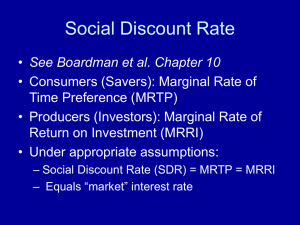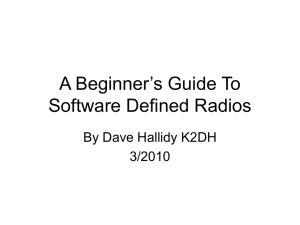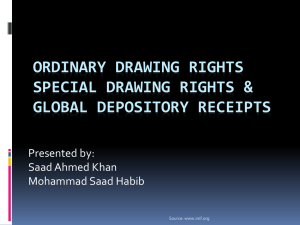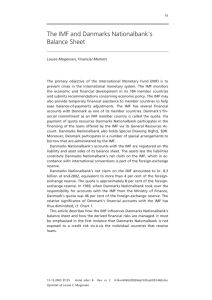Reforming the International Monetary System in the 1970s and 2000s
advertisement
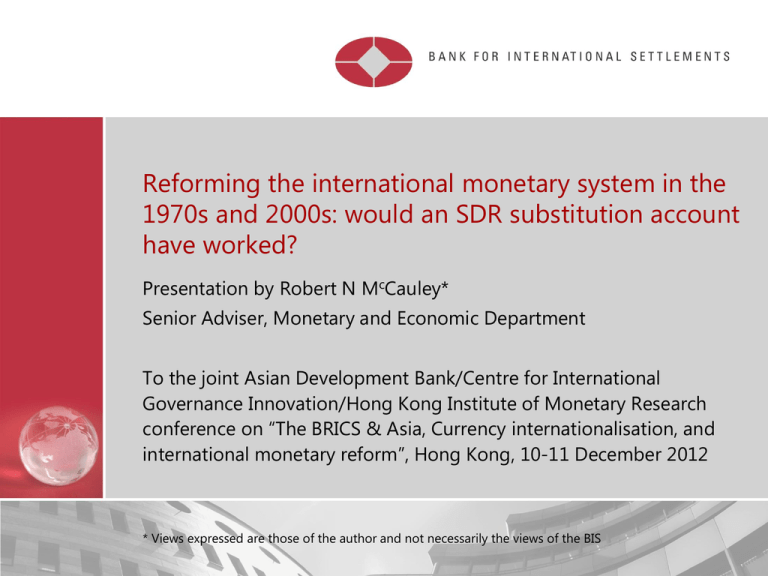
Reforming the international monetary system in the 1970s and 2000s: would an SDR substitution account have worked? Presentation by Robert N McCauley* Senior Adviser, Monetary and Economic Department To the joint Asian Development Bank/Centre for International Governance Innovation/Hong Kong Institute of Monetary Research conference on “The BRICS & Asia, Currency internationalisation, and international monetary reform”, Hong Kong, 10-11 December 2012 * Views expressed are those of the author and not necessarily the views of the BIS Restricted Global crisis gives new evidence of dollar dominance… Dollar shortage as non-US banks scramble for dollars European banks need $ to fund US mortgage securities, loans to Asian borrowers Dollar used in 90%+ of forward transactions Huge premium for dollars in forward markets Natural experiment in Polish & Hungarian forex markets: local currencies trade vs € for months then back to $: $ stable equilibrium Unlimited Fed swaps to major central banks Restricted 2 …but also brings back a long-standing alternative: the SDR Ted Truman convinced US Treasury to support issuance of SDR Still SDR single-digit percentage of forex reserves Gov Zhou embraces Triffin, SDR-based international monetary system 2008 BIS Annual Report argues that an SDR based system would still required last-resort lending in constituent currencies Truman proposes that IMF issue SDRs to Fed/ECB/… to fund swaps(!) Restricted 3 A single point of failure: a need for pluralism? Kindleberger: leadership in global finance is stabilising Political scientists dub this hegemony Pluralism in international monetary system promises: Joint control of growth of international liquidity Fair sharing of rents Protection against errors/ self-interest of hegemon Restricted 4 Varieties of Triffin Original: US s-t debt growing with global econ undermines gold link. Like 1st speculative attack model of Henderson & Salant/Krugman. Ignored that Bank of England managed gold link with little gold. Genberg & Swoboda argue: It’s the policies, stupid! Generalised: Padoa-Schioppa: national policies unlikely to lead to global liquidity (however defined) growing at global optimum Fiscal version: US government debt growing with global demand for reserves is inconsistent with US fiscal sustainability. Ignores generation of safe assets w govt guarantees. Ignores ability of banks and other sovereigns to produce safe assets in the dollar. Restricted 5 Hard to argue a global lack of liquidity (by any def)! True, 2011 CGFS report uses “shortage” twice as much as “excess”. But see Caruana speech to SEACEN governors in Ulaanbator. Central bank balance sheets swollen; over ½ of US Treas held by off’s. Safe assets shrinking with downgrades but expanding w deficits and expansion of agency debt So those seeking more pluralism may look to substitution-type remedies that lower dollar share without increasing global liquidity. Restricted 6 Downgrades take toll on government bond markets Restricted 7 International monetary reform Recurring doubts about ability of US dollar to continue to serve as the primary global reserve currency Exorbitant privilege: unbalanced adjustment Relative size of US economy declining Dollar exchange rate weakening Size of US external liabilities rising Vulnerability to ‘tipping point’: disruptive transition to multipolar or other dominant asset 1960s, 1970s, 2000s: revival of old proposals: Kenen (2010), Bergsten (2007), Camdessus (2009), Landau (2009), Palais Royale Initiative (2011), Angloni et al (2011), Farhi et al (2011) 8 Reform plans 1961-67: Special Drawing Right (SDR) Composite valuation, right to borrow convertible currencies Triumph of consensus over clarity Not a big reserve asset (2.6% global reserves) - Strictly official sphere of exchange - Unit of account, store of value, not a means of exchange How to make SDR more “useful” to allow it to take on the properties needed to be a reserve asset New push: SDR “serves as the light in the tunnel for the reform of the international monetary system”: Zhou (2009) 9 Substitution Account 1974 1973-74: Part of C20 proposals Exchange USD for SDR through a Substitution Account (at IMF) US worried about return paid on dollars in the Account Others want US to pay off its liabilities William Dale (US): “Unless the proponents of the various schemes had some practical way of dealing with the problem of financial obligation on the part of the reserve centers [i.e. the United States], little progress could be made” Overtaken by oil crisis 10 Substitution Account 1978 IMF MD Witteveen proposes rich countries “deposit” dollars equivalent to a fresh allocation of SDR into an Account at the IMF (dollars to be invested in US Treasury coupon securities) Prevent SDR allocation from increasing international liquidity in inflationary environment Begin to replace dollar reserves with SDR reserves Rejected by United States and Europe US would have to borrow dollars to deposit Could weaken confidence in dollar Some view as too lenient on US – want US to pay off liabilities Too small to make a difference 11 Lessons and unresolved issues of early versions US support crucial to any scheme’s success, but US Treasury is ambivalent over setting up a reserve rival to the US dollar. The appropriate return on SDR/USD liabilities/assets in the Account? The need for the US to take on a substantial share of any burden of keeping a scheme’s assets as large as its liabilities. The desire of the Europeans that the United States amortise its obligations, making the international monetary system symmetric. Governance of IMF: since less developed countries seek an important voice in negotiations, need to look beyond G10 if IMF to be involved 12 Substitution Account MD de Larosiere proposal 1978-80 Cautious response, no drive from Ministers March 1979 US Treas Solomon: enhance use of SDR w/o hurting $ confidence G5 deliberations (UK, DE, FR, US, JP) April-August 1979 Legal obstacles, burden of adjustment and exchange risk June 1979 Financial Secretary Nigel Lawson: “we should not waste valuable manpower on matters such as the IMF substitution account. Over the years I can recall no aspect of the financial scene where so much high-powered effort has been expended to so little return” August 1979: IMF Exec Bd prolonged wrangling gives no positive advice to Ministers October 1979: Ministers meeting Belgrade: $ crisis, no progress April 1980: Abandoned 13 Obstacles by 1980 Political – needs to pass national legislatures No mechanism to ensure US pays off its liabilities (shift from central banks to IMF) Rich countries would benefit most (constrains use of IMF resources) Ensuring solvency How set returns on SDR liabilities and $ assets Burden sharing (US vs others) Terms of liquidation IMF simulations suggest possibility of substantial losses (up to 35% of capital) 14 Issues Open economy Fisher hypothesis that higher yields offset depreciation did not hold: USD depreciation exceeds modest yield premium over SDR rates Interest payable options: Treasury bill rate 20 year Treasury bond rate Whitelaw: “Ultimately, the substitution account could be effectively guaranteed only if the US Government followed economic policies that tended to maintain the value of the dollar”: but fear that mechanism reduces discipline on US US can’t undertake to guarantee the SDR value of the Account – so how is the risk shared? US vs creditors (at least 50-50) IMF – via gold reserves 15 Graph 1 SDR and US Treasury bill yields, 1980-2010 In per cent Source: IMF. SDR rate payable on SDR claims on Account US Treasury bill rate earned by dollar liabilities of Account 16 Graph 2 US Treasury bill and bond yields In per cent Note: Due to data break from January 1987 through September 1993, the 10-year bond yield is used instead. Source: Federal Reserve Economic Data. Majority view: US should pay higher of 20-year bond rate or Treasury bill rate 17 Burden sharing Participants contribute callable capital IMF pledges gold to support the value of the Account 20-25 million ounces (out of total 32 million) to cover fund of SDR50 billion 20% of value of Account Equivalent to amount of gold sold to benefit less developed countries Gold proposals contested Would benefit rich countries, contravene IMF Articles At what point is the decision on liquidation taken? How long will unrealised losses be allowed to run? 18 Simulations SDR50 million in deposits of dollars Profits of 25 million ounces of gold Optimistic timing: mid-1980 start, Treasury bill rate paid on dollars Historically more realistic Mid-1981 start (need to gather the participants and enact legislation where required) 20-year Treasury bond rate (would work) 19 Graph 4 Substitution Account’s solvency: baseline scenario In billions of SDRs As a percentage of assets Sources: IMF; authors’ estimates. 20 Graph 7 Account’s solvency: start mid-1981; pay Treasury bill rate In billions of SDRs Sources: IMF; authors’ estimates. Insolvent within 5 years and would not have recovered, even given rise in price of gold since 2008 21 Graph 8 Substitution Account’s solvency: start 1980; pay Treasury bond yield In billions of SDRs As a percentage of assets Sources: IMF; authors’ estimates. 22 Conclusions Existing studies don’t take account of the complex reasons for failure in 1980 These obstacles still persist (burden sharing, risk sharing, amortisation, politics of main beneficiaries) Start date is critical to outcome (but hard to judge ex ante): our scenarios start with USD trough (more favourable) Optimistic scenario that IMF gold was deployed is still not enough to ensure solvency unless US was convinced to pay 20year bond yield (currently 2-5 yr bonds usually held as reserves) Need to keep re-opening the Account to make an impact on distribution of reserves (SDR50bn cumulates to 5% reserves by 2010) but timing etc. complicated 23

